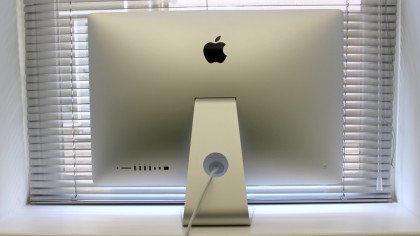TechRadar Verdict
The Retina iMac really is a sight to behold, and works beautifully. It'll cost you, but it looks like something special for the money.
Pros
- +
Truly amazing screen
- +
Does high-end editing smoothly
- +
Still a very small footprint
Cons
- -
Only 8GB of RAM standard
- -
Basic GPU may be limiting for some pros
- -
Price is quite high
Why you can trust TechRadar
When Apple announced the iMac with Retina 5K display toward the end of 2014, it didn't come as a shock. The Cupertino-based company slimmed down its previous-generation iMacs two years earlier, and it felt like a matter of time before they would join a growing fleet of Retina-equipped products that now includes the iPhone 6, iPad Air 2 and the new MacBook.
Going one further than 4K, the Retina iMac's 5K display features a pixel-resolution of 5,120 x 2,800, which lends it more than 14.7 million pixels - four times that of the non-retina 27-inch iMac.
But instead of running at its native resolution, which would render elements on the desktop uncomfortably tiny to use, the new iMac uses the same pixel-doubling scaling as Apple's Retina smartphones, tablets and notebooks to make icons, text and Retina-coded apps appear incredibly sharp and detailed.

Going from an iPhone 3GS to an iPhone 4 (and an iPad 2 to an iPad 3) in the past, I've become accustomed to the leap in clarity that upgrading to one of Apple's Retina devices brings - but the new iMac is on another level.
After ogling its display for several weeks, going back to a regular monitor is like stepping back into a previous era. At 217ppi, it's technically short of the MacBook Pro with Retina's 228ppi, but its larger display means that you can do more - whether it's editing high-resolution images without having to zoom out, or editing 4K movies at 100% in Final Cut Pro X with the timeline in full view.
Even everyday tasks such as browsing the web, answering email and chatting on social networks are more enjoyable and less taxing on the eyes.
Cost control
Of course, the experience doesn't come cheap. Starting at £1,999 (US$2,499 or AUS$2,999), the new iMac can't be had with loose change and Apple is pitching the machine at multimedia types who actually need all those pixels - from videographers to image editors - in addition to regular computer users with deep pockets.
Sign up to the TechRadar Pro newsletter to get all the top news, opinion, features and guidance your business needs to succeed!

The base model gets you a 3.5GHz (Turbo Boost to 3.9GHz) quad-core Intel Core i5 Haswell CPU, 8GB of RAM, a 1TB Fusion Drive and AMD Radeon R9 M290X 2GB graphics. Souping it up to the maximum config adds an extra £1,520 (around US$2,267 or AUS$2,913) to the total cost. In comparison, a similarly specced non-Retina iMac starts at £1,599 (US$1,999 or AUS$2,449), a difference of £400 (around US$597 or AUS$766).
It's worth bearing in mind that Apple's recent OS X 10.10.3 Yosemite update means that Late 2013 27-inch iMac and later can now drive a 4K display, which can now be had for under £300 (around US$448, or AUS$575). That means that you can pick up the latest non-Retina 27-inch iMac - still an attractive machine in itself - and a 4K display as a secondary monitor for less than the cost of a Retina iMac.

However, if you're not prepared to accept anything less than 5K without digging deep for the new iMac, options are limited where OS X is concerned. While Yosemite's latest update includes support for Dell's 27-inch UP2715K 5K display, it retails for a cool £1,200 (around US$1,793 or AUS$2,300).
Moreover, that monitor is only currently supported by the Retina 5K iMac (which you're trying to avoid) or the Late 2013 Mac Pro, which at a base cost of £2,499 (US$2,999 or AUS$3,999) is even less affordable than the Retina iMac itself.
And no: the Retina iMac doesn't support Target Display Mode, unfortunately, meaning that you can't connect computers, consoles and other devices via Thunderbolt or mini-DisplayPort to display their contents; it's a real shame too.

